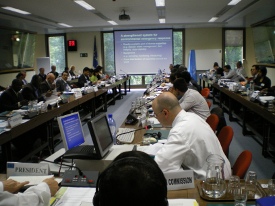

International work
Key AGEE Initiatives

The Flash Environmental Assessment Tool (FEAT)
To identify acute environmental risks immediately following disasters

To identify acute environmental risks immediately following disasters
Tropical Cyclone Nargis Myanmar: Radip Environmental Assessment
16th – 21st May 2008 by Leif Jonsson, Swedish Rescue Services Agency

16th – 21st May 2008 by Leif Jonsson, Swedish Rescue Services Agency
Over the years the AGEE has painstakingly reviewed lessons from major environmental conflicts and disasters to develop excellent tools and guidelines for emergency management. Some of these initiatives include:
The Environmental Emergencies Partnership - With disasters on the rise, greater stakeholder involvement, collaboration, knowledge development and sharing, and capacity building are needed. At the 2002 World Summit on Sustainable on Sustainable Development an array of international and national organizations and governments launched the Environmental Emergencies Partnership to reduce the frequency and severity of environmental emergencies through more effective preparedness, prevention and response.
Mobile Laboratory to Support United Nations Environmental Emergency Response - A modular unit known as the Environmental Assessment Module (EAM) was developed by the Netherlands to support international responses to environmental emergencies in countries that lack specialist knowledge or capacity. EAM can be rapidly deployed for disasters involving hazardous substances, together with the relevant technical expertise and two fully-equipped off-road vehicles. The one vehicle contains a mobile measurement and analysis unit, the other contains materials for logistical support such as satellite equipment and GPS. The entire unit can be transported in a cargo aircraft. When deployed, the EAM is supported by a knowledge network of research institutions and Ministries in the Netherlands to ensure affected countries receive the best available support.
Flash environmental assessment tool - FEAT is a "first aid" tool to identify environmental impacts, and support initial response actions in disaster contexts. It does not take the place of in-depth environmental assessments, which may be appropriate at later stages of the disaster response. Findings from use of the FEAT are be communicated quickly to appropriate organizations so that appropriate actions can be taken. A comprehensive training initiative is now underway to empower technical experts around the world to be able to apply FEAT during early stage emergency response.
Hazard Identification Tool - The objective of the
Hazard Identification Tool (HIT) is to alert the UN Country
Team and emergency responders to potential secondary risks after a
natural disaster posed by large infrastructure and industrial
facilities containing hazardous materials located in the affected
area. This information can be shared with competent local and
national authorities as appropriate. Any actual secondary risk
should be addressed at the earliest possible stage.
The HIT provides the user with the (expected) location of hazards
in the affected area. In addition, the substances that are expected
to be present in these facilities are listed, as also the hazard
type for the whole of the substances.
The last column gives the estimated impact type of the hazard. An
example of the practical outcomes of this tool is available to
download: the "UNDAC Disaster Response Preparedness Mission to
Papua New Guinea in April 2009" In March 2009, floods hit
Northern Namibia and the HIT assessment can be downloaded as
another example.

Green Cross applauds the work of the amazing network of experts, donor agencies, national governments and passionate individuals involved in improving our ability to respond to global disasters to save lives and protect the environment.
We are delighted that GCA CEO Mara Bun will represent the global Green Cross network on the new Steering Committee set up by AGEE to advance this work. We need to involve more national governments, funding bodies, NGOs and global media in this important effort.
In particular Asia Pacific is a focus point for capacity development of global response resources and Green Cross Australia looks forward to playing a role in building traction for emergency response cooperation.
Copyright © Green Cross Australia | Terms & Conditions | Privacy Policy
web design brisbane :: (zero)seven
